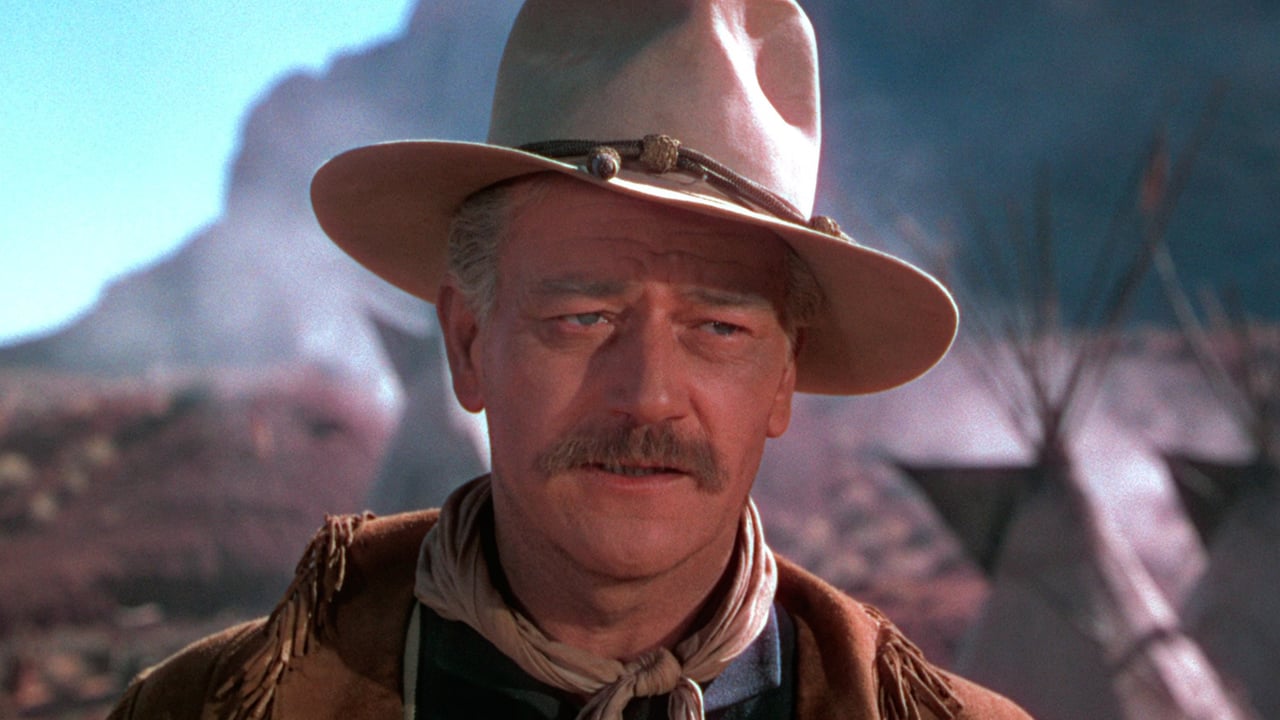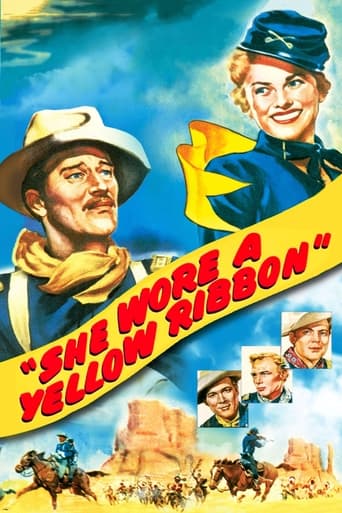

John Wayne plays Capt. Nathan Brittles, whose imminent plans of retirement are interrupted by General Custer's forces being wiped out in his famous "last stand". Being stationed near the threatening Native forces, he is ordered to evacuate the wife of the fort's commanding officer, and her niece(played by Joanne Dru) who has caught the romantic attentions of two officers(played by John Agar & Harry Carey Jr.) She has taken to wear a yellow ribbon in her hair, which symbolizes her affection for one of them, but she won't say who, which leads to conflict. Of course, this is nothing compared to the expected Native onslaught that Brittles tries desperately to prevent...Well directed by John Ford, this time in color, with much of his stock company of actors in key roles, and presents a thoughtful story, with a good conclusion(though there is some unfortunate comedy relief with Victor McLaglen!)
... View MoreJohn Ford finally relented in his preference for B&W film making to give us a long overdue look at the predominantly rusty-colored spectacular Monument Valley backdrops featured in major portions that took place outside of the fort. The sequences when the cavalry is walking their horses, with a thunderstorm or mist in the background, are particularly memorable as a mood setter.Duke Wayne is back from the previous year's "Fort Apache", again as second in command, technically. But this time, he pretty much runs the show, with minimal interference from easy-going fort-bound Major MacAllshard, who is very different from Fonda's up-tight dictatorial Colonel Thursday in "Fort Apache". Here, Wayne plays a much older man, around 60, who is due to retire in a few days. Very much the father figure for the younger set. John Agar also returns from "Fort Apache" to play a similar role as the young lieutenant romantic lead. But instead of actual wife Shirley Temple, he has equally luscious-looking Joanne Dru to woo. And, he has stiff competition this time from Harry Carey Jr.. The volatile relationship between these 3 very much brings back memories of a similar sparring between cavalrymen Errol Flynn and Ronny Reagan over Olivia de Havilland, in "Santa Fe Trail". Dru's character is even named Olivia. Actually, Olivia seems much more in love with Wayne's mature character than with the sparring young duo. Obviously, Ford was impressed with the acting of Duke and feisty Dru in the previous year's outstanding western "Red River". Wayne is back with his older, more authoritarian, persona exhibited in that film, plus a moustache. But, again, the mood of the film is quite different: much more relaxed.Ben Johnson, another relatively young buck, is given his most visible film role to that point, as Wayne's chief scout. Likable Ben was a real Oklahoma cowboy and champion horse rider, and would team with Harry Carey Jr. as the laconic male stars in Ford's "The Wagon Masters", the following year. Dru would also return as the female star in that film. Ben rode two famous horses in this and the latter films: Steel and Bingo. Steel was valued as making riders look especially good, while Bingo was a champion galloper.The abundant music, while repetitive, consists mostly of well-known spirited traditional songs, mostly about sweethearts, often sung by troops through the years, including my Vietnam-era training troop. It certainly adds to the generally relaxed, jovial, tone of the film.Charismatic Victor McLaglen is back from "Ft. Apache", serving as the thoroughly Irish, whiskey-fired, top sergeant cut up. He is the star of an extended slapstick brawl. Ford often had at least one fisted brawl in his westerns, which might be serious, slapstick, or a mix of the two. He always included some humor in his films, however subtle, and there is plenty in this one. One type of humor is running gags or lines. Duke's repetitive "Never apologize, it's a sign of weakness" is an example. The film opens with an attack by Cheyenne Dog Soldiers(a military-oriented brotherhood) on the fort paymaster stage, to obtain money to buy more rifles. 20 years later, the much Vietnam War-influenced cavalry western "Soldier Blue" would open with a similar Cheyenne attack, again to obtain money to buy rifles. Unlike "Ft. Apache" and the subsequent "Rio Grande", a battle with Apaches is not included in this film. Besides Cheyenne, Arapahoes, Kiowas, and Comanches are mentioned as putting aside their traditional animosities, forming a common military alliance against rapidly encroaching Europeans. As in "Ft. Apache", Wayne makes a daring parley visit to the hostile 'Indian' encampment. There are no battles between mounted 'Indians' and cavalry. In several instances, the cavalry merely sees the results of an 'Indian' attack, including the satisfying murder of the gun-running fort sutlers. However, there is the late dramatic stampeding of the 'Indian' warrior's horses through their camp in the dead of night, as Wayne's commission as a soldier expires. The point was to limit the ability of the warriors to fight, with minimal bloodshed on either side. This episode encapsulates the result of the historic Red River War, headed by Colonel MacKenzie, which effectively ended the Indian Wars on the southern plains. Another MacKenzie-lead exploit is the basis of the subsequent "Rio Grande".... Wayne thinks his military career is now over, and we see him riding off into the sunset. But, he's in for a surprise!Irishman Ford actually identified with Native Americans as another group, who like the Irish, were commonly persecuted by mainstream Anglo-Saxon society. Thus, he usually tried to portray them in a relatively favorable light, although he knew that most of his audiences expected them to be mostly cast as expendable impediments to western expansion. This favoritism is seen most vividly in his last cavalry western: "Cheyenne Autumn", especially in the bizarre "Dodge City" segment.
... View MoreSomething inspired John Ford to make a cavalry trilogy in the late 1940's. It started in 1948 with Fort Apache, continued by She Wore a Yellow Ribbon, one year later, and the last of the trilogy Rio Grande (1950). The film in the middle, She Wore a Yellow Ribbon, was the only one shot in color and that is one of the things people remember it by. The gorgeous soulful images of the wild west gave Winton C. Hoch an Oscar for Best Cinematography. The reason why Ford decided to make the trilogy is simple; he and his crew took part in WWII which was an experience that changed his career for ever - all of his subsequent films would be about war in one way or another; no matter whether it was a comedy (The Quiet Man) or a ruthless western (The Searchers).An old captain Nathan Brittles is five days away from being retired but the death of 200 hundred soldiers lead him to his last mission. He's not sure what to do after he gets retired because the cavalry is where he belongs. He is in between of past and future, and is unable of talking about his feelings; except the monologues to the grave of his wife which represents direct discussion with history - the only time he feels as his own; the theme of aging was a very common theme for John Ford.She Wore a Yellow Ribbon is a nostalgic western characterized with beautiful images full of sentimentality about the past of a nation, history and presence. It's important to remember that a historic film is always a description of two different ages, intentionally or unintentionally, the age portrayed and the age the film was made in. John Ford's films of the cavalry trilogy are without a doubt allegorical tales of post-war States; meanings and feelings about the war. The trilogy most certainly isn't escapism that someone might easily think it is - the topic is very serious, history isn't the main topic - but the presence.The film is remembered for its soulful imagery, not just because of the beauty in them, but because they defined the film. She Wore a Yellow Ribbon speaks through images and sounds - not through the story. Sentimentality, emotions about yearning and loss, the dignity of recessive men are passed to the audience through sights and sounds - not through textual themes.The visual magnificence of She Wore a Yellow Ribbon really speaks to its viewer. The extraordinary, mythical, colors are like directly from a beautiful mural where small details just start to melt and lose their meaning - personal melancholy clearly exhales from these soulful sights and sounds.
... View MoreThis may be a better movie than "Fort Apache".Here's what I liked:Undoubtedly one of Wayne's best career performances. At least as good as in "Red River". Ironic to see him playing a character 20 years older than himself, since he spent the next 15 years playing characters who were 10 to 20 years younger than himself. Thematically sound -- duty, aging, changing of the guard.Colorful Civil War references. Sergeant Tyree (Ben Johnson) is a former high ranking officer in the Confederate army.Ben Johnson is very good as the savvy scout.Monument Valley is stunning. Won an Oscar for cinematography.Fantastic stunt work as usual with the horses and wagons.Great example of John Ford's colorful, sentimental world of military fetish. Ford has a tendency to overdo the comic relief. He gets just about the right balance here. Victor McLaglen doing the heavy comic lifting again.Here's what kept it from being better:The plot is skimpy. They ride to the station to relieve a patrol and drop off two women at the stagecoach station. They come back. They run the Indians horses off. The end. The romantic subplot doesn't work. Joanne Dru looks good, but her character is annoying and gratuitous.There's virtually no heavy. The Indians are not well characterized.That's it. Really enjoyed this movie!! Tough to get eight stars from me!
... View More